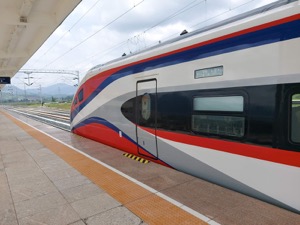A information to the Laos-China Railway from Vientiane to Boten, together with tickets, practice varieties, station guides, onboard facilities, and transport to stations.
The Laos-China Railway is a semi-high-speed railway in Laos that operates from Vientiane to Boten, with most important stations in Vang Vieng, Luang Prabang, and Muang Xai.
Right here every little thing you might want to know concerning the Laos-China Railway.
Laos-China Railway information
Laos-China Railway map
About the Laos-China Railway
Buying tickets
Stations
Station security
Restaurants and shops
Station toilets
Express and Local Services
Onboard the Laos-China Railway
Seats onboard the Laos-China Railway
Onboard food
Onboard toilets
Views from the train
Transport to stations
International travel to China
Further reading
Laos-China Railway map
Concerning the Laos-China Railway
The Laos-China Railway is 414.332 kilometres, of which there are 258.5 kilometres of bridges and tunnels.
The road is a typical gauge (similar as China and Europe) and makes use of electric-powered trains (EMU). The road is on a single monitor with passing loops. Categorical trains have an working pace of 160 km/h. Native trains and cargo trains journey as much as 120 km/h.
[160 km/h on the Laos-China Railway.]Web site: http://www.lcrc.ltd/
Fb: Laos – China Railway Company Limited
Shopping for tickets
[Muang Xai ticket office.]The official Laos-China Railway web site doesn’t promote tickets, so the best manner to purchase tickets on-line is through the web journey agent Baolau.
There are a number of different methods to purchase tickets, so right here is my information on learn how to purchase tickets for the Laos-China Railway.
Stations
There are 10 passenger stations on the Boten-Vientiane line:
– Boten
– Na Teuy
– Na Moh
– Muang Xay
– Muang Nga
– Luang Prabang
– Kasi
– Vang Vieng,
– Phon Hong
– Vientiane
Station safety
The stations have airport-style safety the place you must have a ticket to enter the stations and your luggage are scanned. Aerosols are listed as a banned merchandise, so my can of deodorant was taken from me.
If you’re bringing in water they make you drink a sip of it to show that it’s not an explosive substance. That is probably the most wise system I’ve seen wherever for liquid safety.
Eating places and retailers
Vientiane has probably the most number of retailers, so you may get there a bit earlier to do some people-watching at a station cafe.
[Pun Cafe at Vientiane Station.]The principle stations have cafes and comfort retailers.
[Cafe Amazon at Vang Vieng.]The stations are in-built undeveloped areas, so there are not any retailers close by. There are some roadside stalls on the entrance to Luang Prabang, however aside from that, don’t anticipate to get something substantial to eat outdoors the stations.
[Roadside stalls at Luang Prabang Station.]One factor that each station has is water fountains serving cold and warm water. This jogged my memory of my travels in China, the place individuals carry their very own flasks of tea, and the place on the spot noodles are served all over the place.
Station bogs
The stations have the choices of sit or squat bogs.
I used to be as soon as once more reminded of my travels in China by the truth that there isn’t a rest room paper. If in case you have been travelling in Southeast Asia for some time you have to be packing your personal in your day bag. If you’re new to this a part of the world, then bear in mind to carry your personal.
Categorical and Native Companies
There are two practice varieties working on this home route. The categorical service travels as much as 160 km/h and solely stops on the most important stations:
– Vientiane
– Vang Vieng
– Luang Prabang
– Muang Xai (provincial capital of Oudomxay province)
– Na Teuy
– Boten (immigration frontier for China)
There may be additionally a neighborhood practice service that runs at a pace of as much as 120 km/h. This one stops all stations and the tickets are cheaper.
Onboard the Laos-China Railway
[Boarding the train at Vientiane.]When this practice service opened it immediately turned probably the most fashionable and quickest railway in Southeast Asia. The quickest practice title now belongs to Whoosh, nevertheless it’s nonetheless a marvel to see such a practice working in Laos.
The journey from Vientiane to Luang Prabang used to take two days earlier than the expressway was constructed, and even now it may possibly take as much as a day. Now it takes lower than two hours to go from Vientiane to Luang Prabang by practice.
Here’s what the categorical practice seems to be like arriving at Luang Prabang:
[Train arriving at Luang Prabang Station.]
The practice can journey at a pace of as much as 160 km/h, making it a semi-high-speed railway. It’s not – as some media shops hold repeating – a high-speed railway. It is a perfect pace for a rustic the scale of Laos.
Seats onboard the Laos-China Railway
The seats in economic system are in a 3×2 configuration, so the seats are a bit narrower in comparison with trains with a 2×2 configuration. It’s nonetheless a snug experience even within the 3-across part.
[5 seats across in economy.]A very powerful factor is leg room, of which there’s a lot. You may simply go somebody within the aisle, or recline your seat with out guilt.
On my return journey from Vang Vieng to Vientiane my seatmate had taken over my house together with her luggage. there’s a lot legroom that I didn’t hassle to maneuver her luggage for the 55-minute journey.
There are energy shops underneath the seats, however no wifi onboard.
I travelled in First Class from Muang Xai to Boten, the place the seats are in 2×2 configuration.
[First Class seats on the Laos-China Railway.]In contrast to an airline, the place the seat hierarchy is Financial system-Enterprise-First, the seat hierarchy on the Laos-China Railway is Financial system-First-Enterprise. The Enterprise Class seats are in 1×2 configuration.
The native practice service has non-reclinable cushioned bench seats in 2×3 configuration.
[Bench seats on the local Laos-China Railway.]Onboard meals
There isn’t a cafe carriage onboard, however there’s a snack cart that trundles up and down the practice through the journey.
There are sizzling water dispensers within the practice for tea and on the spot noodles.
Onboard bogs
One of many most important causes that trains are higher than buses is which you could go to the bathroom everytime you need.
The categorical trains have the choice of squat bogs or sitting bogs.
Just like the stations, there isn’t a rest room paper, so come ready.
Squat rest room on the native practice.
Views from the practice
There are some wonderful views from the practice, although when you go north of Vang Vieng you will see quite a lot of the within of tunnels (there are such a lot of tunnels!)
[Passing through a tunnel on the Laos-China Railway.]Right here is what to anticipate outdoors the tunnels.
[View near Vang Vieng.] [Mekong crossing near Luang Prabang.] [Second Mekong crossing.]Transport to stations
Vientiane station is 17 km outdoors the town centre, so you might want to consider further journey time to get there. Google Maps mentioned it was half-hour within the morning, and we received there in 20 minutes.
Coming again to Vientiane it took about 55 minutes by bus to get from the station to the central bus station in peak hour site visitors.
We received a personal taxi that was organized by the lodge for 170,000 LAK. On the best way again I received the native bus that goes to the central bus station for 15,000 LAK.
Vang Vieng Station is about 4 km from the town centre. The transport costs are:
Shared tuktuk: 30,000 LAK
Personal tuktuk 50,000 LAK
Motorcycle taxi: 20,000 LAK
Luang Prabang Station is about 12 km from the historic centre of Luang Prabang, and it took about 25 minutes to get there. I used to be questioning what the transport scenario could be like right here as it should most certainly be the preferred cease for tourism.
Once we arrived we received a shared tuktuk with two Laotians. One of many males was a policeman (he confirmed us his ID) and all of us paid 50,000 LAK every. With the policeman paying the identical charge I guessed we paid the proper fare. On the best way again I rented a personal tuktuk for 80,000 LAK, and my good friend went again earlier and rented a personal automotive for 170,000 LAK. The official shared minivan value is listed at 35.000 LAK.
Muang Xai Station is about 3 km from the town centre.
Electrical trolley: 5,000 LAK
Shared tuktuk: 30,000 LAK
Personal tuktuk: 50,000 LAK
Worldwide journey to China
The railway is linked to the Yuxi–Mohan railway, which is the Chinese language part of the Laos–China Railway. There’s a every day service between Vientiane and Kunming South.
There’s a separate worldwide entrance at Boten to clear immigration.
At Boten station you must go away the practice and observe the trail to the worldwide part of the station.
You’ll need to verify in case you want a visa earlier than reserving a practice ticket to China.
Tickets for practice between Laos and China may also be booked through Baolau.
Buy Vientiane – Kunming train tickets.
Additional studying
I’ve a historic archive of the construction of the Vientiane-Boten Railway.
Learn extra about Laos railways.
This practice information is a part of the Southeast Asia railways information.
Source link







